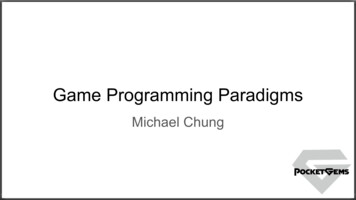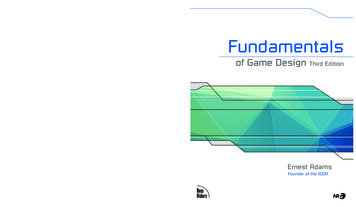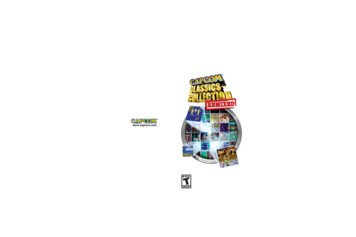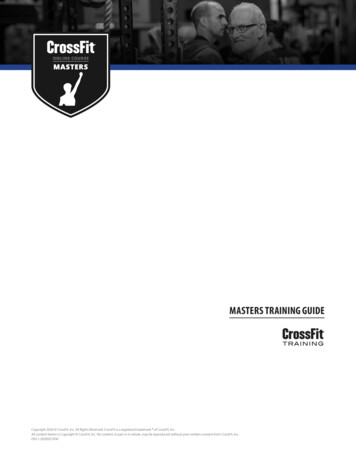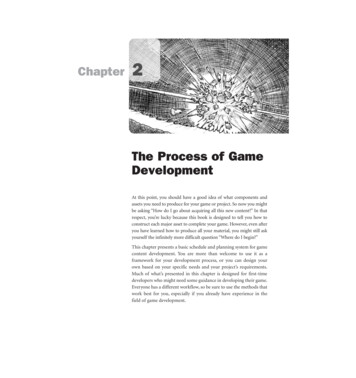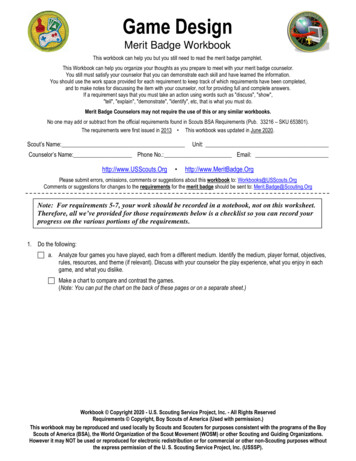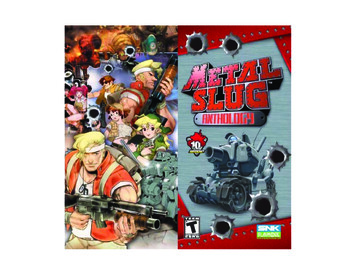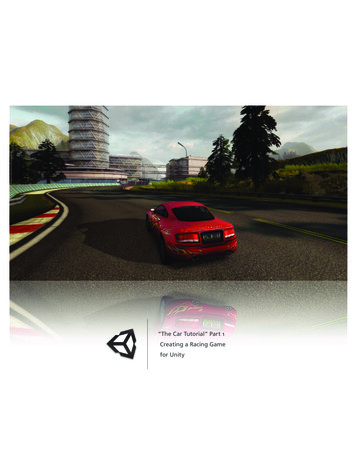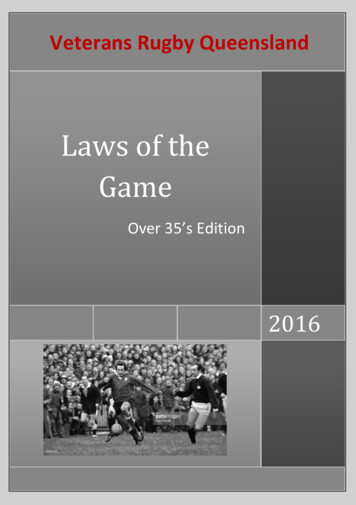
Transcription
Veterans Rugby QueenslandLaws of theGameOver 35’s Edition2016
FOREWORDThe Veterans Rugby Laws embody and reflect the spirit ofVeterans Rugby. The aim of the Laws and the variationsdescribed in this booklet are to provide a less competitiveversion of the game in which player enjoyment is maximisedand the possibility of injury is minimised. The cynical disregardof the laws of the game, dangerous or overly vigorous play andunsportsmanlike behaviour are not part of the Veteransethos. The World Rugby (formerly IRB) ‘Laws of the Game ofRugby’ also apply to Veterans but are modified by thevariations described in this book.The Spirit of Veterans RugbyThe spirit of Veterans Rugby is epitomised in the motto “Fun,Friendship and Fraternity”. This international motto is thecentral theme of every game of Veterans Rugby.Our own motto is “Maximum Enjoyment, Minimum Harm”THE REFEREE IS THE SOLE JUDGE OF FACT, LAW AND GOODTIMES. NO DISCUSSION OR ABUSE, IS WARRANTED, WANTEDOR NEEDED.
ResponsibilityRugby Union is a sport which involves physical contact. Anysport involving physical contact has inherent dangers. It is veryimportant that players play the Game in accordance with theLaws of the Game and be mindful of the safety of themselvesand others.It is the responsibility of players to ensure that they arephysically and technically prepared in a manner which enablesthem to play the Game, comply with the Laws of the Gameand participate in accordance with safe practices.
CharterIncorporating World Rugby’s Values but subject to VeteranRugby variationsThe Charter covers the basic principles of Rugby as they relateto playing and coaching, and to the creation and application ofthe Laws. It is hoped that the Charter, which is an importantcomplement to the Laws of the Game, will set the standardsfor all those who are involved in Rugby, at Veterans level.IntroductionThe legend of William Webb Ellis, who is credited with firstpicking up the football and running with it, has doggedlysurvived the countless revisionist theories since that day atRugby School in 1823. That the Game should have its originsin an act of spirited defiance is somehow appropriate.SPIRITRugby owes much of its appeal to the fact that it is played bothto the letter and within the Spirit of the Laws. Theresponsibility for ensuring that this must happen, lies not withone individual – it involves coaches, captains, players andreferees.Rugby provides a unifying spirit that leads to life-longfriendships, camaraderie, teamwork and loyalty whichtranscends cultural, geographic, political and religiousdifferences
Principles of the GameWORLD RUGBYIntegrity is central to the fabric of the Game and is generatedthrough honesty & fair playIntegrityIt is through discipline, control and mutual respect that theSpirit of the Game flourishes and, in the context of a Game asphysically challenging as Rugby, these are the qualities whichforge the fellowship and sense of fair play so essential to theGame’s on-going success and survival.OBJECTThe object of the Game is that two teams, each of fifteenplayers, observing fair play, according to the Laws and in asporting spirit should, by carrying, passing, kicking andgrounding the ball, score as many points as possible.The wide variation of skills and physical requirements neededfor the Game mean that there is an opportunity for individualsof every shape, size and ability to participate at all levels.
CONTEST AND CONTINUITYThe contest for possession of the ball is one of Rugby’s keyfeatures. These contests occur throughout the Game and in anumber of different forms: In contact In general play
LAWS OF RUGBYBefore the MatchLaw 1 – The GroundDEFINITIONSThe Ground is the total area shown on the plan. The Groundincludes:VETERANS RUGBY VARIATION:Goal posts and other markings may be omitted or varied asagreed between the teams before the game.THE FIELD OF PLAY - is the area (as shown on the plan)between the goal lines and the touchlines. These lines are notpart of the field of play.THE PLAYING AREA - is the field of play and the in-goal areas(as shown on the plan). The touchlines, touch-in-goal lines anddead ball lines are not part of the playing area.THE PLAYING ENCLOSURE - is the playing area and a spacearound it, not less than 5 metres where practicable, which isknown as the perimeter area.IN-GOAL - is the area between the goal line and the dead ballline, and between the touch-in-goal lines. It includes the goalline but it does not include the dead ball line or the touch-ingoal lines.
‘The 22’ - is the area between the goal line and the 22-metreline, including the 22-metre line but excluding the goal line.The Plan, including all the words and figures on it, is part of theLaws.Picture of a rugby enclosure with all the relevant lines
1.1SURFACE OF THE PLAYING ENCLOSURE(a)Requirement. The surface must be safe to play on atall times.(b)Type of surface. The surface should be grass but mayalso be sand, clay, snow or artificial grass. The game may beplayed on snow, provided the snow and underlying surface aresafe to play on. It shall not be a permanently hard surface suchas concrete or asphalt. In the case of artificial grass surfaces,they must conform to World Rugby Regulation 22.1.2REQUIRED DIMENSIONS FOR THE PLAYINGENCLOSURE(a)Dimensions. The field of play does not exceed 100metres in length. Each in-goal does not exceed 22 metres inlength. The playing area does not exceed 70 metres in width.(b)The length and breadth of the playing area are to beas near as possible to the dimensions indicated. All the areasare rectangular.(c)The distance from the goal line to the dead ball line willpreferably be not less than 10 metres.(d)No relevance to veteran rugby(e)The perimeter area should not be less than 5 metreswhere practicable.
1.3(a)LINES ON THE PLAYING ENCLOSURESolid LinesThe dead ball lines and touch-in-goal lines, both of which areoutside the in-goal areas;The goal lines, which are within the in-goal areas but outsidethe field of play;The 22-metre lines; which are parallel to the goal linesThe half way line which is parallel to the goal lines; andThe touchlines which are outside the field of play.(b)Dash LinesAll lines other than solid lines are dash lines all of which are 5metres in length.There are two sets of dash lines which are 10 metres from, andparallel to, each side of the half way line. These are called the10 metre dash lines. The 10 metre dash lines intersect thedash lines which are 5 metres and 15 metres parallel to eachtouch line.There are two sets of dash lines which are 5 metres from, andparallel to, each touch line.They run from the 5 metre dash lines, which are parallel toeach goal line and intersect both 22 metre lines, both 10 metre
dash lines and the half way line. These are called the 5 metredash lines.There are two sets of dash lines which are 15 metres from, andparallel to, each touch line.These dash lines run from the 5 metre dash lines which areparallel to each goal line, and intersect both 22 metre lines,both 10 metre dash lines and the half way line. These arecalled the 15 metre dash lines.There are six dash lines 5 metres from, and parallel to, eachgoal line. Two dash lines are positioned 5 metres and 15metres from each touch line. A further two dash lines arepositioned in front of each goal post so that there is 5 metresbetween these dash lines.(c)CentreThere is one line 0.5-metre-long that intersects thecentre of the half way line.1.4(a)DIMENSIONS FOR GOAL POSTS AND CROSSBARThe distance between the two goal posts is 5.6 metres.(b)The crossbar is placed between the two goal posts sothat its top edge is 3.0 metres from the ground.(c)The minimum height of the goal posts is 3.4 metres.
(d) When padding is attached to the goal posts the distancefrom the goal line to the external edge of the padding mustnot exceed 300mm.1.5FLAG POSTS(a)There are 14 flag posts with flags, each with a minimumheight of 1.2 metres above the ground.(b)Flag posts must be positioned at the intersection oftouch-in-goal lines and the goal lines and at the intersection ofthe touch-in-goal lines and the dead ball lines. These eight flagposts are outside the in-goal area and do not form part of theplaying area.(c)Flag posts must be positioned in line with the 22-metrelines and the half way line, 2 metres outside the touchlines andwithin the playing enclosure.1.6OBJECTIONS TO THE GROUND(a)If either team has objections about the ground or theway it is marked out they must tell the referee before thematch starts.(b)The referee will attempt to resolve the issues but mustnot start a match if any part of the ground is considered to bedangerous.
Law 2 – The Ball2.1SHAPEThe ball must be oval and made of four panels.2.2DIMENSIONSLength in line 280 - 300 millimetresCircumference (end to end) 740 - 770 millimetresCircumference (in width) 580 - 620 millimetres2.3MATERIALSLeather or suitable synthetic material. It may be treated to2.4WEIGHT410 - 460 grams2.5AIR PRESSURE AT THE START OF PLAY65.71-68.75 kilopascals, or 0.67-0.70 kilograms per squarecentimetre, or 9.5-10.0 lbs per square inch.2.6SPARE BALLSSpare balls may be available during a match, but a team mustnot gain or attempt to gain an unfair advantage by using themor changing them.
Law 3 – Number of Players. The TeamAS AMENDED FOR VETERANS RUGBY:DEFINITIONSA TeamA team consists of fifteen players who start the match plus anyauthorised replacements and/or substitutes.ReplacementA player who replaces an injured team-mateSubstituteA player who replaces a team-mate for tactical reasons3.1AREAMAXIMUM NUMBER OF PLAYERS ON THE PLAYINGMaximum: each team must have no more than fifteen playerson the playing area during play.3.15 Rolling substitutions.Rolling substitutions shall be implemented. Team numbersshall comply with Law 3 unless agreed between the teamcaptains and referee before kick-off.Substitution of players is permitted at any time and a playersubstituted earlier may return to the game at any time.
3.2TEAM WITH MORE THAN THE PERMITTED NUMBEROF PLAYERSObjection: at any time before or during a match a team maymake an objection to the referee about the number of playersin their opponents’ team. As soon as the referee knows that ateam has too many players, the referee must order the captainof that team to reduce the number appropriately.Sanction: Penalty at the place where the match would restart.3.3WHEN THERE ARE FEWER THAN FIFTEEN PLAYERSA Union may authorise matches to be played with fewer thanfifteen players in each team.When that happens, all the Laws of the Game apply exceptthat each team must have at least five players in the scrum atall times.3.4PLAYERS NOMINATED AS SUBSTITUTES(This section is not applicable to Veterans Rugby)3.5THE FRONT ROW - REPLACEMENTS AND SUBSTITIONS(This section is not applicable to Veterans Rugby)3.6UNCONTESTED SCRUMSUnder Veterans Rugby laws all scrums will be uncontested.
3.7SENT OFF FOR FOUL PLAYA player sent off for foul play may be replaced or substitutedunder Veterans’ rugby laws. The player will take no furtherpart in that game, Refer to Law 10.6.3.8PERMANENT REPLACEMENTA player may be permanently replaced if injured. If the playeris permanently replaced, that player must not return and playin that match. The replacement of the injured player must bemade when the ball is dead and with the permission of thereferee.3.9THE DECISION FOR PERMANENT REPLACEMENT(a(This section is not applicable to Veterans Rugby)(b)(This section is not applicable to Veterans Rugby)3.10 THE REFEREE’S POWER TO STOP AN INJURED PLAYERFROM CONTINUINGIf the referee decides – with or without the advice of a doctoror other medically qualified person – that a player is so injuredthat the player should stop playing, the referee may order thatplayer to leave the playing area. The referee may also order aninjured player to leave the field in order to be medicallyexamined.
3.11TEMPORARY REPLACEMENT - BLOOD INJURY(a)When a player has a blood injury, which hasuncontrolled active bleeding (a blood injury), that player maybe temporarily replaced. The injured player must return toplay as soon as the bleeding has been controlled and/orcovered3.12 TEMPORARYASSESSMENTREPLACEMENT-HEADINJURYIf, at any point during a match, a player is concussed or hassuspected concussion, that player must be immediately andpermanently removed from the field of play. This is known as“Recognise and Remove”.3.13PLAYER WISHING TO REJOIN THE MATCH(a)A player who has a blood injury which has uncontrolledactive bleeding must leave the playing area. The player mustnot return until the bleeding is controlled and the wound hasbeen covered.(b)A player who leaves a match because of injury or anyother reason must not re-join the match until the refereepermits the player to return. The referee must not let a playerre-join a match until the ball is dead.(c)If a player re-joins or a replacement/substitute joins thematch without the referee’s permission, and the refereebelieves the player did so to help that player’s team or
obstruct the opposing team, the referee penalises the playerfor misconduct.Sanction: A penalty kick is awarded at the place where playwould restart.3.15ROLLING SUBSTITUTIONSA Union may implement rolling substitutions at defined levelsof the Game within its jurisdiction. The number ofsubstitutions must not exceed twelve. The administration andrules relating to rolling substitutions are the responsibility ofthe Union having jurisdiction.
Law 4 – Players Clothing & Veterans Coloured ShortsDEFINITIONSPlayers’ clothing is anything players wear.A player wears a jersey, shorts and underwear, socks andboots.The sleeve of a jersey must extend at least half way from theshoulder point to the elbow.Detailed information relating to the permitted specificationsfor clothing and studs, maybe found in World Rugbyspecifications (Regulation 12).4.1ADDITIONAL ITEMS OF CLOTHING(a)A player may wear supports made of elasticated orcompressible materials which must be washable.(b)A player may wear shin guards which conform with,World Rugby Specifications (Regulation 12).(c)A player may wear ankle supports worn under socks,not extending higher than one third of the length of the shinand, if rigid, from material other than metal.(d)A player may wear mitts (fingerless gloves) which mustconform to World Rugby Specifications (Regulation 12).(e)A player may wear shoulder pads which must bear theWorld Rugby Approval Mark (Regulation 12).
(f)A player may wear a mouth guard or dental protector.(g) A player may wear headgear which must bear the WorldRugby Approval Mark (Regulation 12).(h)A player may wear bandages and/or dressings to coveror protect any injury.(i)A player may wear thin tape or other similar materialas support and/or to prevent injury.LAW AMENDMENT TRIAL(j)A player may wear goggles which must bear the WorldRugby Approval Mark (Regulation 12).4.2SPECIAL ADDITIONAL ITEMS FOR WOMEN(This section is not applicable to Veterans Rugby)4.3STUDS(a)Studs of players’ boots must conform with the WorldRugby Specifications (Regulation 12).(b)Moulded rubber multi-studded soles are acceptableprovided they have no sharp edges or ridges.
4.4BANNED ITEMS OF CLOTHING(a)A player must not wear any item that is contaminatedby blood.(b)A player must not wear any item that is sharp orabrasive.(c)A player must not wear any items containing buckles,clips, rings, hinges, zippers, screws, bolts or rigid material orprojection not otherwise permitted under this Law.(d)A player must not wear jewellery such as rings orearrings.(e)A player must not wear gloves.(f)A player must not wear shorts with padding sewn intothem.(g)A player must not wear any other item which does notconform to World Rugby Specifications for such clothing(Regulation 12).(h)A player must not wear any item that is normallypermitted by Law, but, in the referee’s opinion that is liable tocause injury to a player.(i)A player must not wear communication devices withinthat player’s clothing or attached to the body.
(j)A player must not wear any additional item of clothingthat does not conform to World Rugby Regulation 12.4.5INSPECTION OF PLAYERS’ CLOTHING(a)The referee or the touch judges appointed by or underthe authority of the match organiser must inspect the players’clothing and studs for conformity to this Law.(b)The referee has power to decide at any time, before orduring the match, that part of a player’s clothing is dangerousor illegal. If the referee decides that clothing is dangerous orillegal the referee must order the player to remove it. Theplayer must not take part in the match until the items ofclothing are removed.(c)If, at an inspection before the match, the referee or atouch judge tells a player that an item banned under this Lawis being worn, and the player is subsequently found to bewearing that item on the playing area, that player is sent offfor misconduct.Sanction: A penalty kick is awarded at the place where play isrestarted.4.6WEARING OTHER CLOTHINGThe referee must not allow any player to leave the playingarea to change items of clothing, unless these are bloodstained.
Law 5 – Time as amended for Veterans Rugby5.1DURATION OF A MATCHGames shall consist of 3 x 20 min periods with the teamschanging ends between periods. There will be a 3 minute restperiod between each period of play.5.2Resting time during the 60 minutesAfter twenty minutes the teams change ends. There is aninterval of not more than 3 minutes.5.3TIME KEEPINGThe referee is the sole judge of time and fact, but maydelegate the duty to either or both the touch judges and/or anofficial time-keeper, in which case the referee signals to themany stoppage of time or time lost. In matches without anofficial time-keeper, if the referee is in doubt as to the correcttime the referee consults either or both the touch judges andmay consult others but only if the touch judges cannot help.5.4TIME LOST(This section is not applicable to Veterans Rugby)
5.6PLAYING EXTRA TIME(This section is not applicable to Veterans Rugby)5.7OTHER TIME REGULATIONS(This section is not applicable to Veterans Rugby)
Law 6 – Match OfficialsDEFINITIONSEvery match is under the control of Match Officials whoconsist of the referee and two touch judges or assistantreferees. Additional persons, as authorised by the matchorganisers may include the reserve referee and/or reserveassistant referee, an official to assist the referee in makingdecisions by using technological devices, the time keeper, thematch doctor, the team doctors, the non-playing members ofthe teams and the ball persons.A touch judge may be appointed by a match organiser or ateam involved in a match and is responsible for signalling,touch, touch in-goal and the success or otherwise of kicks atgoal.6.AREFEREEBEFORE THE MATCH6.A.1 APPOINTING THE REFEREEThe referee is appointed by the match organiser. If noreferee has been appointed the two teams may agree upon areferee. If they cannot agree, the home team appoints areferee.
6.A.2 REPLACING THE REFEREEIf the referee is unable to complete the match, the referee’sreplacement is appointed according to the instructions of thematch organiser. If the match organiser has given noinstructions, the referee appoints the replacement. If thereferee cannot do so, the home team appoints a replacement.6.A.3 DUTIES OF THE REFEREE BEFORE THE MATCH(a) Toss. The referee organises the toss. One of the captainstosses a coin and the other captain calls to see who wins thetoss. The winner of the toss decides whether to kick off or tochoose an end. If the winner of the toss decides to choose anend, the opponents must kick off and vice versa.Prior to kick off, the match referee will identify and draw theattention of players to those wearing coloured shorts. Playerswill be briefly reminded of the requirements that apply tothose wearing coloured shorts (i.e. both in connection withtackling and in the distance those wearing certain colouredshorts may run with the ball). When a player wearing colouredshorts substitutes for another player, the referee will againdraw attention to the fact that a player wearing colouredshorts is now on the field.
DURING THE MATCH6.A.4 THE DUTIES OF THE REFEREE IN THE PLAYINGENCLOSURE(a)The referee is the sole judge of fact and of Law duringa match. The referee must apply fairly all the Laws of the Gamein every match.(b)The referee keeps the time.(c)The referee keeps the score.6.A.5 ENTERING OR LEAVING THE PLAYING AREA(a)Authorised medically trained persons may enter theplaying area during the match to attend to injured players.They must only enter the playing area if it is safe to do so.(b)Persons carrying water for the players may only enterthe playing area during a stoppage in play for an injury to aplayer.6.A.8 THE REFEREE’S WHISTLE(a)The referee must carry a whistle and blow the whistleto indicate the beginning and end of each half of the match.(b)The referee has the power to blow the whistle and stopplay at any time.(c)The referee must blow the whistle to indicate a score,or a touch-down.
(d)The referee must blow the whistle to stop play becauseof an infringement or for an offence of foul play. When thereferee cautions or sends off the offender, the referee mustwhistle a second time when the penalty kick or penalty try isawarded.(e)The referee must blow the whistle when the ball hasgone out of play, or when it has become unplayable, or whena penalty is awarded.(f)The referee must blow the whistle when it would bedangerous to let play continue or when it is probable that aplayer has been seriously injured.6.A.9 THE REFEREE AND INJURYIf the referee stops play because a player has been injured,and there has been no infringement and the ball has not beenmade dead, play restarts with a scrum. The team last inpossession throws in the ball. If neither team was inpossession, the attacking team throws in the ball.6.A.10 THE BALL TOUCHING THE REFEREE(a)If the ball or the ball carrier touches the referee andneither team gains an advantage, play continues. If eitherteam gains an advantage in the field of play, the referee ordersa scrum and the team that last played the ball has the throwin.
(b)If either team gains an advantage in in-goal, if the ballis in possession of an attacking player the referee awards a trywhere the contact took place.(c)If either team gains an advantage in in-goal, if the ballis in possession of a defending player, the referee awards atouch down where the contact took place.6.A.11 THE BALL IN IN-GOAL TOUCHED BY NON-PLAYERThe referee judges what would have happened next andawards a try or a touch down at the place where the ball wastouched.AFTER THE MATCH6.A.12 SCORE – Under Veterans LawThe game will always finish as a draw.6.B.1 Appointing touch judges and assistant referees.If touch judges / assistant referees are not available, thereferee shall take sole charge of the game.6.B.3 CONTROL OF TOUCH JUDGES AND ASSISTANTREFEREESThe referee has control over both, touch judges or assistantreferees. The referee may tell them what their duties are, andmay overrule their decisions. If a touch judge is unsatisfactorythe referee may ask that the touch judge be replaced. If the
referee believes a touch judge is guilty of misconduct, thereferee has power to send the touch judge off and make areport to the match organiser.6.B.4 WHERE THE TOUCH JUDGES OR ASSISTANT REFEREESSHOULD BE(a)There is one touch judge or assistant referee on eachside of the ground. The touch judge or assistant refereeremains in6.B.5 TOUCH JUDGE OR ASSISTANT REFEREE SIGNALS(a)Each touch judge or assistant referee carries a flag orsomething similar with which to signal decisions.(c)Signalling touch. When the ball or the ball carrier hasgone into touch, the touch judge or assistant referee musthold up the flag.The touch judge or assistant referee must stand at the placeof the throw-in and point to the team entitled to throw in. Thetouch judge or assistant referee must also signal when the ballor the ball carrier has gone into touch-in-goal.Signalling touch and team to throw in(d)When to lower the flag. When the ball is thrown in, thetouch judge or assistant referee must lower the flag.
(e)It is for the referee, and not the touch judge orassistant referee, to decide whether or not the ball wasthrown in from the correct place.AFTER THE MATCH6.C.2 THOSE WHO MAY ENTER THE PLAYING AREAIn the case of injury, only the match doctor and/or the nonplaying members of the team who are medically trained (onlyqualified Doctors or Physiotherapists) may enter the playingarea while play continues.The other non-playing members of the team may enter theplaying area while play continues, provided they havepermission from the referee. Otherwise, they enter only whenthe ball is dead. Such persons must not obstruct, interfere ormake any comments to the match officials.
Law 7 – Mode of PlayPlaying a MatchA match is started by a kick-offAfter the kick-off, any player who is onside may take the balland run with itAny player may throw it or kick it within the restrictions ofkicking in veteran rugby lawsAny player may give the ball to another playerAny player may tackle, hold or push an opponent holding theball with the exception and restrictions relating to colouredshortsAny player may fall on the ballAny player may take part in a scrum, ruck, maul or lineoutAny player may ground the ball in the in-goalA ball carrier may hand-off an opponentWhatever a player does must be in accordance with the lawsoff the game and within the spirit of veteran’s rugby.Veterans Rugby VariationsA player may only kick the ball at kick-off, taking a penalty kick,free kick or when inside his own 22m area. (Kicking in general
play outside a team’s 22 metre area will result in a scrum beingawarded to the non-offending team, where the kick tookplace).Tackles and hand-offs (fending) are subject to restrictions inregard to players wearing coloured shorts (see Veterans Rugbyvariation to Law 15).
Law 8 – AdvantageDEFINITIONSThe Law of advantage takes precedence over most other Lawsand its purpose is to make play more continuous with fewerstoppages for infringements. Players are encouraged to playto the whistle despite infringements by their opponents.When the result of an infringement by one team is that theiropposing team may gain an advantage, the referee does notwhistle immediately for the infringement.8.1ADVANTAGE IN PRACTICE(a)The referee is sole judge of whether or not a team hasgained an advantage. The referee has wide discretion whenmaking decisions.(b)Advantage can be either territorial or tactical.(c)Territorial advantage means a gain in ground.(d)Tactical advantage means freedom for the nonoffending team to play the ball as they wish.8.2WHEN ADVANTAGE DOES NOT ARISEThe advantage must be clear and real. A mere opportunity togain advantage is not enough.
If the non-offending team does not gain an advantage, thereferee blows the whistle and brings play back to the place ofinfringement.8.3WHEN THE ADVANTAGE LAW IS NOT APPLIED(a)Referee contact. Advantage must not be applied whenthe ball, or a player carrying it, touches the referee.(b)Ball out of tunnel. Advantage must not be appliedwhen the ball comes out of either end of the tunnel at ascrum without having been played.(e)After the ball has been made dead. Advantage cannotbe played after the ball has been made dead.8.4IMMEDIATE WHISTLE WHEN NO ADVANTAGEThe referee blows the whistle having determined that anadvantage cannot be gained by the non-offending team.8.5MORE THAN ONE INFRINGEMENT(a)When there is more than one infringement by thesame team: If advantage cannot be played or does not accrue tothe second offence, the referee applies the appropriatesanction to the offence which is most advantageous to thenon- offending team.
If either sanction is for foul play the referee appliesthe appropriate sanction to the offence which is mostadvantageous to the non-offending team. The referee mayalso temporarily suspend, or order off, the offending player.(b)If advantage is being played following an infringementby one team and then the other team commit aninfringement, the referee blows the whistle and applies thesanctions associated with the first infringement. If eitherinfringement is for foul play, the referee applies theappropriate sanction for that offence. The referee may alsotemporarily suspend, or order off, the offending player.
Law 9 – Method of Scoring9.ASCORING POINTS9.A.1 POINTS VALUESTry. When an attacking player is first to ground the ball in theopponents’ in-goal, a try is scored. (Value 1pt)Veterans Rugby VariationsNo Penalty Kicks, Conversions or Drop Goals.The referee shall declare all Veterans Rugby games a draw atthe final whistle.
Law 10 – Foul PlayDEFINITIONSFoul play is anything a player does within the playing enclosurethat is against the letter and spirit of the Laws of the Game. Itincludes obstruction, unfair play, repeated infringements,dangerous play and misconduct which are prejudicial to theGame.10.1OBSTRUCTION(a)Charging or pushing. When a player and an opponentare running for the ball, either player must not charge or pushthe other except shoulder-to-shoulder.Sanction: Penalty kick(b)Running in front of a ball carrier. A player must notintentionally move or stand in front of a team-mate carryingthe ball thereby preventing opponents from tackling thecurrent ball carrier or the opportunity to tackle potential ballcarriers when they gain possession.Sanction: Penalty kick(c)Blocking the tackler. A player must not intentionallymove or stand in a position that prevents an opponent fromtackling a ball carrier.Sanction: Penalty kick
(d)Blocking the ball. A player must not intentionally moveor stand in a position that prevents an opponent from playingthe ball.Sanction: Penalty kick(e)Ball carrier ru
of the laws of the game, dangerous or overly vigorous play and unsportsmanlike behaviour are not part of the Veterans ethos. The World Rugby (formerly IR) ZLaws of the Game of Rugby [ also apply to Veterans but are modified by the variations described in this boo



